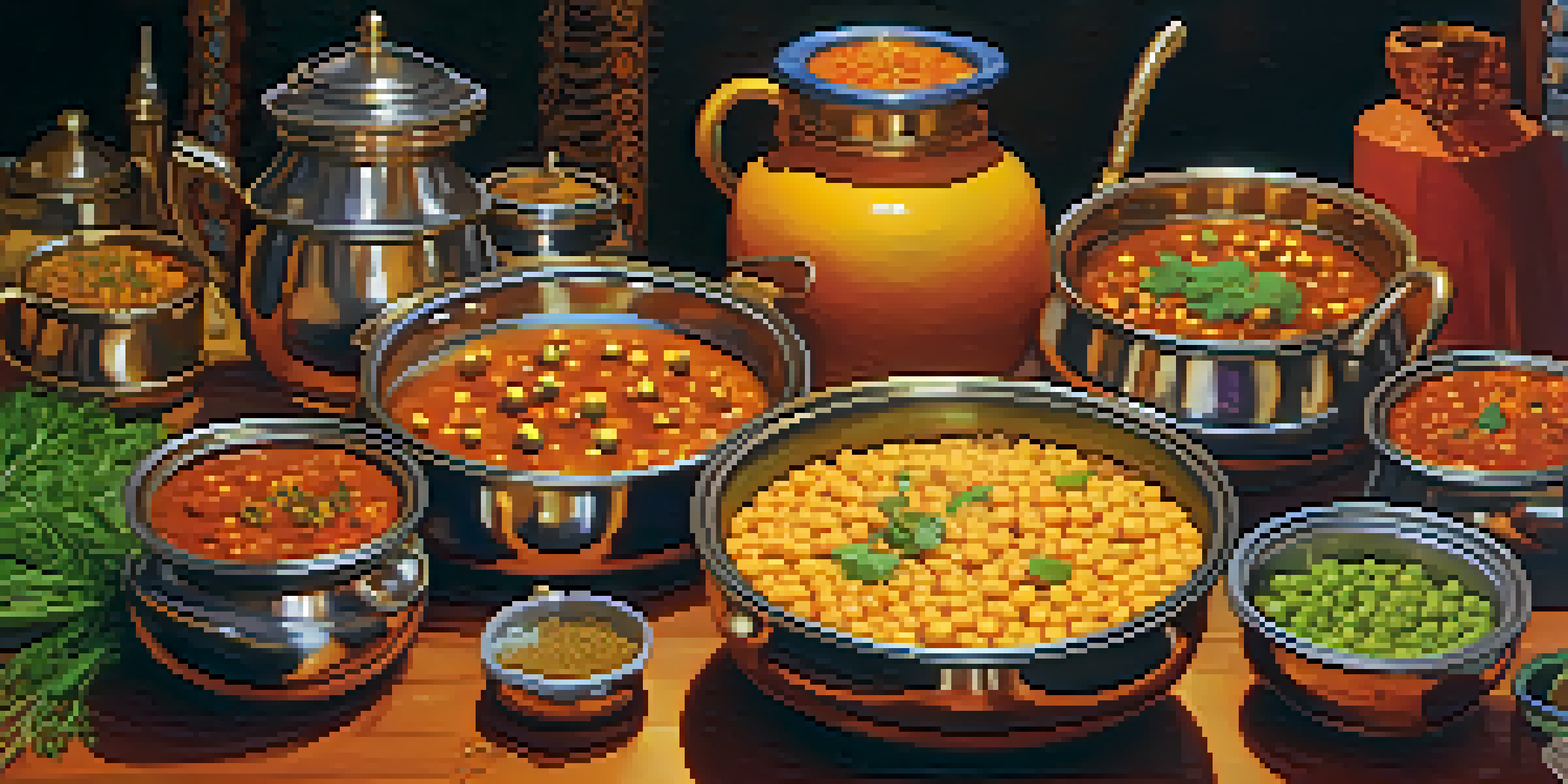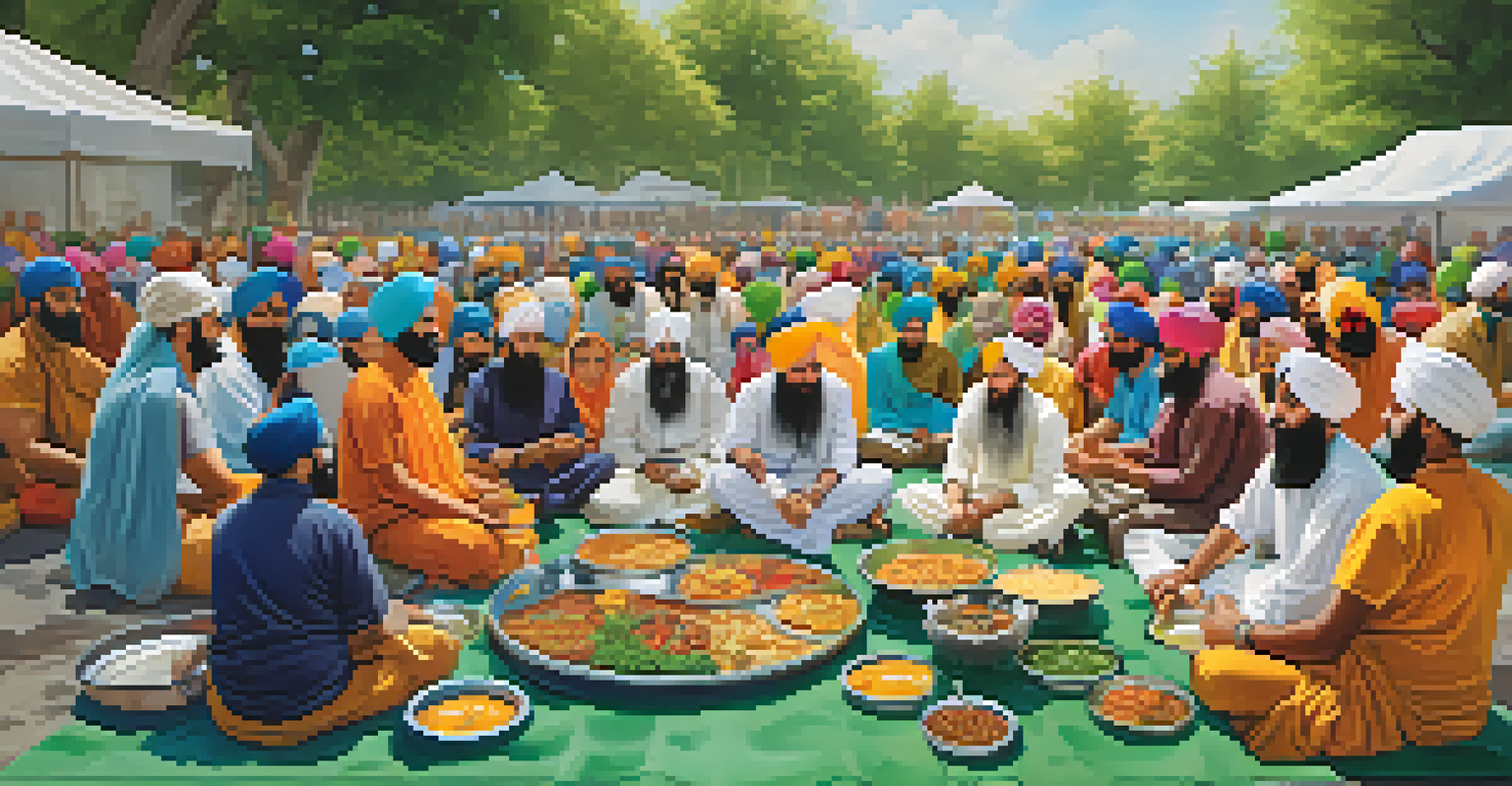The Role of Religion in Shaping Indian Culinary Practices

The Intersection of Religion and Food in India
In India, food is more than just sustenance; it’s a reflection of cultural and religious identities. Each religion brings its unique flavors, ingredients, and cooking techniques to the culinary table. This intersection creates a diverse tapestry of culinary practices that varies widely across the country, influenced by local beliefs and traditions.
Food is symbolic of love when words are inadequate.
For instance, Hinduism emphasizes vegetarianism, leading to a rich array of plant-based dishes. On the other hand, Islam introduces flavorful meat dishes, such as biryani, which are often prepared with specific cooking methods to align with halal practices. This blending of culinary traditions results in a vibrant food culture that showcases the best of each religion.
As a result, religious festivals often feature specific foods that hold symbolic meanings. Whether it’s the sweets prepared during Diwali or the special meals served during Ramadan, these culinary practices reinforce the connection between food and faith, making every bite a celebration of cultural heritage.
Vegetarianism: A Key Element of Hindu Cuisine
Hinduism’s emphasis on ahimsa, or non-violence, plays a crucial role in vegetarianism across India. Many Hindus abstain from meat as a way to honor this principle, leading to a rich tradition of vegetarian cooking. This dietary choice has resulted in an impressive variety of vegetarian dishes that are both nutritious and flavorful.

Dishes like paneer tikka, chana masala, and a plethora of dals showcase how vegetarian food can be both satisfying and diverse. The use of spices, herbs, and fresh vegetables creates a culinary experience that rivals meat-based dishes in terms of complexity and taste. This approach not only caters to vegetarians but also attracts meat-eaters who appreciate the depth of flavor.
Food Reflects Cultural Identities
In India, food serves as a vibrant reflection of cultural and religious identities, showcasing a rich tapestry of culinary practices unique to each faith.
Moreover, festivals and religious observances often feature special vegetarian recipes that are prepared with care and devotion. The act of cooking and sharing these dishes during celebrations fosters a sense of community and belonging, reinforcing the idea that food is a fundamental part of religious expression in Hindu culture.
The Influence of Islam on Indian Cuisine
Islamic dietary laws have significantly shaped Indian culinary practices, especially in areas with large Muslim populations. The concept of halal, which dictates what is permissible to eat, influences everything from the choice of ingredients to cooking methods. This results in a unique set of culinary traditions that have enriched Indian cuisine.
The act of eating is a communal ritual that brings people together and strengthens bonds.
Popular dishes like kebabs, biryanis, and nihari showcase the flavors and techniques that have been passed down through generations. The use of aromatic spices and slow-cooked preparations reflects a meticulous approach to cooking that emphasizes quality and taste. These dishes not only satisfy hunger but also create a sense of pride in cultural heritage.
Additionally, the celebration of festivals such as Eid brings families together to share special meals, highlighting the communal aspect of Islamic culinary traditions. The preparation and sharing of food during these occasions reinforce bonds among community members, making food an essential part of religious and social life.
Jainism: The Strictest Adherence to Vegetarianism
Jainism's strict adherence to non-violence takes vegetarianism to another level, influencing culinary practices in India profoundly. Jains avoid not only meat but also certain vegetables that could harm living organisms, such as root vegetables. This unique perspective on food reinforces the importance of compassion toward all living beings.
As a result, Jain cuisine is characterized by its creativity, using a wide variety of plant-based ingredients while adhering to strict guidelines. Dishes like Jain curry or besan chilla showcase how flavorful and diverse vegetarian food can be, even within these constraints. This culinary approach highlights the ability to innovate while respecting deeply held religious beliefs.
Festivals Celebrate Culinary Traditions
Religious festivals in India highlight the importance of food, with traditional dishes symbolizing joy and gratitude while fostering community bonds.
Moreover, during religious observances, Jains prepare special meals that align with their dietary restrictions, promoting a sense of community. Sharing these dishes during festivals or family gatherings serves as a reminder of their values and traditions, making every meal an expression of their faith.
Buddhism and the Concept of Mindful Eating
In Buddhism, the practice of mindful eating is closely tied to the philosophy of mindfulness and compassion. Many Buddhists choose vegetarianism or veganism as a way to cultivate awareness around food choices, emphasizing the importance of not causing harm to living beings. This approach extends beyond diet, encouraging a deeper connection to the food they consume.
Buddhist cuisine often features simple yet wholesome ingredients, with an emphasis on fresh vegetables, grains, and legumes. Dishes like vegetable stir-fry or rice with lentils highlight the idea that food can nourish both the body and mind. The focus on seasonal and local produce also fosters sustainability, aligning with Buddhist principles of living harmoniously with nature.
Additionally, food plays a significant role in community practices, such as sharing meals in monasteries. This communal aspect reinforces the bond among practitioners and serves as a reminder of the interconnectedness of all life, making each meal an opportunity for reflection and gratitude.
Regional Variations: How Religion Shapes Local Cuisine
India's vast diversity means that regional variations in cuisine are often influenced by local religions and beliefs. For instance, coastal regions with significant Christian populations may have seafood-centric dishes, while areas with large Hindu communities focus on vegetarian fare. These regional influences create a rich mosaic of culinary traditions across the country.
In Punjab, for example, the Sikh tradition of langar promotes communal eating, featuring simple yet hearty vegetarian meals served to all, regardless of background. This practice not only fulfills physical hunger but also fosters a sense of equality and community. Similarly, in the southern states, the influence of Hindu festivals results in a plethora of rice-based dishes that are both festive and flavorful.
Diverse Dietary Practices Across Religions
Each religion in India contributes distinct dietary practices, from vegetarianism in Hinduism to halal in Islam, enriching the culinary landscape.
These regional variations illustrate how religion and geography intertwine to create unique culinary practices. Exploring these differences provides a deeper understanding of India’s cultural fabric, showcasing how food serves as a bridge between faith and local traditions.
The Role of Festivals in Culinary Practices
Religious festivals in India are vibrant celebrations that often revolve around food, showcasing the integral role of culinary traditions in these events. Each festival has its own set of traditional dishes that are prepared with love and devotion, often holding symbolic meanings tied to the occasion. From the sweets of Diwali to the savory dishes of Eid, food becomes a way to express joy and gratitude.
During these festivals, families come together to prepare elaborate meals, creating a sense of community and shared purpose. The act of cooking and sharing food strengthens familial bonds and fosters connections within the community. This communal aspect of festival cooking highlights the importance of food as a social glue that brings people together.

Moreover, the preparation of festival foods often involves age-old recipes passed down through generations. This not only preserves culinary heritage but also reinforces the connection between food, family, and faith. In this way, festivals become a celebration of culture, with food at the heart of the festivities.
Conclusion: The Enduring Impact of Religion on Indian Cuisine
The role of religion in shaping Indian culinary practices is profound and multifaceted, influencing everything from dietary choices to cooking methods. As we’ve explored, each religion contributes its own unique flavors and traditions, creating a diverse and vibrant food culture. This culinary landscape not only reflects the beliefs and values of various communities but also serves as a means of expressing identity and heritage.
The importance of food in religious observances and festivals illustrates how deeply intertwined these aspects of life are. Whether through vegetarian dishes, halal preparations, or mindful eating practices, food remains a central theme in the expression of faith. This connection enriches the culinary experience, making every meal a reflection of history and tradition.
In a world that often feels increasingly disconnected, the role of religion in shaping Indian cuisine reminds us of the power of food to bring people together. It serves as a delicious reminder of our shared humanity, making every bite an opportunity to celebrate diversity and community.